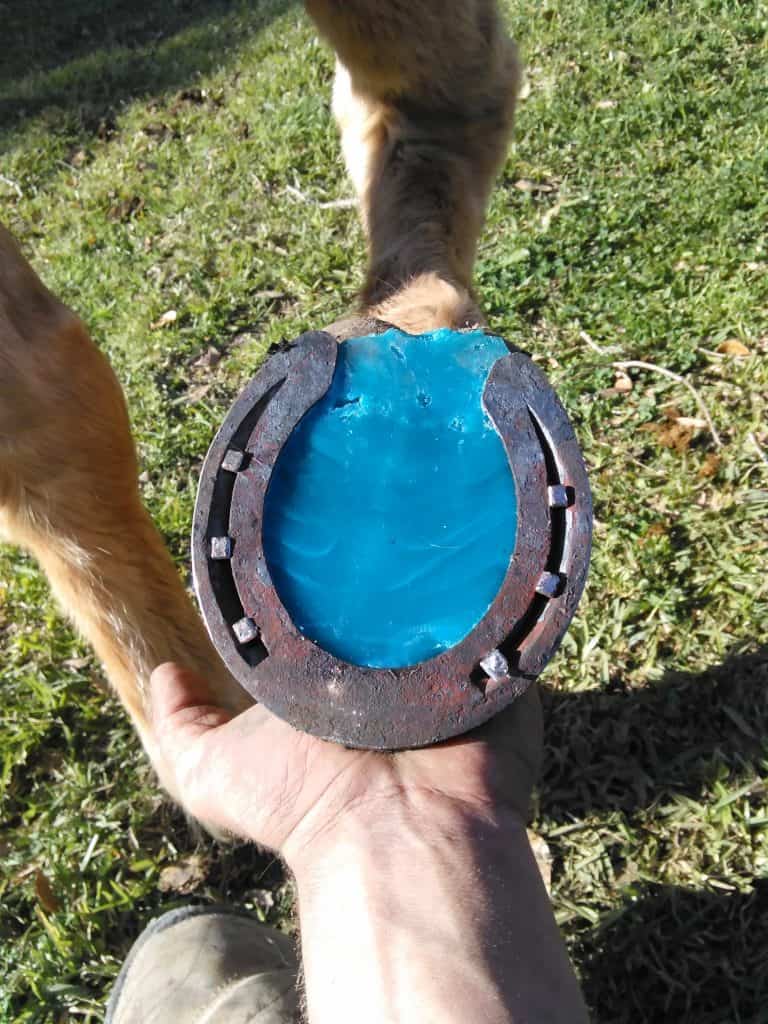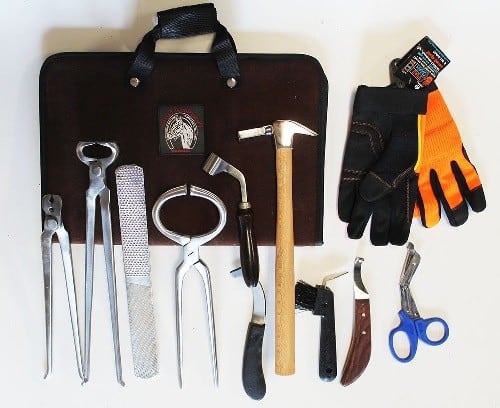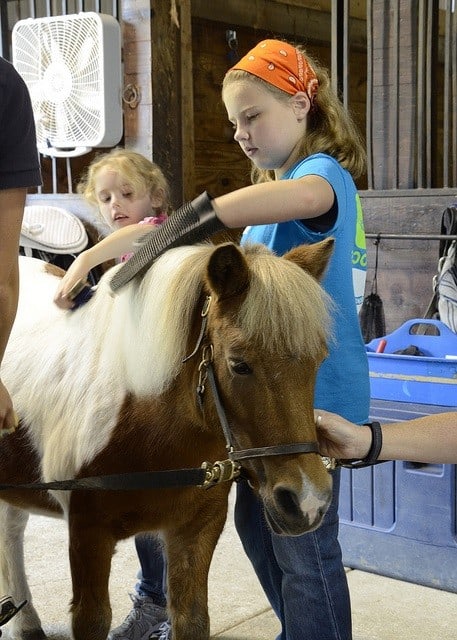Proper horse grooming is essential. Without regular grooming, your horse can be vulnerable to numerous health problems, especially hoof-related. There are certain things to keep in mind before grooming your horse:
- Horses are large animals.
- You have to have full control over them, even when they are superbly trained.
- Remember that a sudden and unfamiliar noise can startle him and make him dash out.
Therefore, it’s critical to keep yourself calm and your actions predictable. Follow the same routine each time so the horse will feel secure in what’s happening.
What’s Involved
There are 2 main elements to grooming a horse:
- Brushing the coat
- Cleaning the hooves
There is no right or wrong order to groom your horse. However, it is a good idea to get into a routine and always do the process the same way, either feet or grooming first, so the horse can anticipate what you are going to do.
Before Grooming a Horse
You must ensure:
- Halter is in position.
- Two cross ties are in place.
- Without cross ties, grooming the horse in his stable can be dangerous.
- His movements can crush you against walls and other objects.
- Installing cross ties is a requirement before you start grooming.
How to Groom a Horse
- Check the horse’s eyes, ears, and mouth for any irregularities.
- Check for bumps or scratches over his body.
- Slide your hand over his hooves, one at a time, to confirm they are well.
- Clean the hooves to remove any foreign matter.
- The hoof area is an integral part of the horse’s body since the accumulation of debris here can lead to hoof infection, which can maim a horse.
- Brush and clean the main and tail to eliminate dried mud, burrs, and other debris.
- Use combs to untangle them to give them a well-groomed look.
- Before riding your horse, you should brush him to be sure there isn’t debris where you will place the saddle.
If someone isn’t riding the horse every day, you may be able to skip some of the care procedures at times.
Grooming a Horse Steps
1. Start with your horse secured in cross ties that are attached to the halter.
This ensures that the horse cannot flick one way or the other, plus it frees up both of your hands to work with the grooming. If you are trying to both groom and hold the horse, you are likely going to find this much more difficult, and there is a greater chance of injury.
2. With the horse secured, start either on the grooming or on the hooves, whichever you prefer.

Cleaning the Hooves
Many owners prefer to start by cleaning the hooves. Then your horse can relax and enjoy the rest of the routine. Have your farrier tool kit ready and accessible.
1. To correctly position yourself, stand next to the horse’s left front shoulder, just to the front of the body.
2. Run your hand, the hand you don’t normally hold the pick in, down the front of the leg until you reach the hoof.
Most horses that have had their feet cleaned will pick up their foot, but if they don’t, gently press your shoulder and upper body against the outside of the shoulder, which will slightly move the horse off balance. He or she will shift weight to the other front foot.
3. When the horse shifts its weight to the other front foot, pick the other foot, bending the leg as it would naturally bend back toward the center of the horse’s body.
4. Hold the hoof firmly in your hand.
5. Use the pick to remove all the debris.
Be very careful not to dig into the frog, which is the soft, triangular-shaped center part of the hoof. This area can be very sensitive.
6. Repeat this process with the other hoof until completed.
7. Be sure to give a treat to the horse after the first hoof and then after you finished the second.
This helps him know he’s doing a great job.
Grooming a Horse Tips
When grooming equine, you can either start with the mane or the tail. If the horse is dirty, muddy or has a winter coat, start with the curry comb and groom the entire body using gentle, circular shaped motions that follow the direction of hair growth.
Work from the neck to the chest, over the shoulders, down the back of the sides and the legs. Remember, the curry comb is not flexible. Be sure to be very gentle on the sides and down the legs.
If your horse is flinching and twitching away, switch to the dandy brush over the sensitive areas.
After the curry comb, follow the same pattern with the dandy brush. This will flick away all the dust and dead hair. Follow-up with the body brush for a shiny, sleek look.
Then gently use the body brush on the face, but not near the eyes. You can use a wet soft cloth or sponge to clean around the eyes and inside the nostrils. Be sure to rinse it out after each use.
Again, being predictable and gentle with your horses will calm them. Having the proper grooming supplies will help you to groom them faster and more thoroughly.
Horse Grooming Supplies
When you have the right horse grooming supplies, it makes maintaining your horses much easier and more effective. These are our favorite grooming products.
Oster Equine Care Series 7-Piece Grooming Kit
This is a reliable set. I think it’s a good value for all the brushes and the quality and long life you will get from them. Something misleading about this set is the 7th piece is the bag, not an additional brush.
This horse grooming kit has everything you need for grooming, detangling and cleaning the hooves. It comes with:
- Grooming brush (stiff)
- Finishing brush (soft)
- Brush for the mane and tail
- Comb for the mane and tail
- Curry comb (coarse)
- Pick for hooves
These are really all the brushes you will need to brush and groom your horse. The bag is nice but we don’t use it. Maybe if we traveled for horse shows we would.
We keep everything in a small bucket. This way we can easily access whatever we need. It also makes it easy to rinse out and store for air drying. We don’t rinse them after every use, but it helps to have clean supplies when grooming a horse. Our horses love when we brush them.
Wahl Professional Animal Equine Sweat Scraper
Depending on the season, your horse might benefit from a sweat scraper. For a horse to cool down, his sweat has to evaporate. In some climates, especially when it’s hot and humid, it takes a lot longer to evaporate. You can use the sweat scrapper to help remove excess moisture. It will help your horse to cool down faster.
Horse sweat scrapers are available in plastic, metal, or wood. They can be used on dogs as well.
Oster A5 Turbo 2-Speed Professional Animal Clipper
These pet grooming clippers work well for horses, dogs, and most any other animals you have. The heavy-duty motor makes it fast and easy to groom your horse. There are two speeds, and it’s easy to switch from one to the other.
This set comes with everything you need, including a 12′ cord, #10 blade, lubricating blade oil, clipper grease, a cleaning brush, and carbon brush replacements.
The only negative is it weighs just under two pounds, so it’s a bit heavy if you are working on your animals for a long time.
If you have a lot of animals to clip, the Andis ProClip AGC2 2-Speed Detachable Blade Clipper does a quality job as well and is a little bit quieter and lighter at 17.5 ounces.
Chlorhexidine Solution (2%)
It’s important to have this on hand for horse wound care. This also works for dogs. When you put it on the wound, it works up to two days. Chlorhexidine works against gram-positive and gram-negative bacteria, including strep, staph, listeria, E. coli, and yeast.
Be sure to follow the directions on the bottle to dilute it properly. Something we do is premix it and keep it handy in small bottle. We use: Vestil BTL-RC-8 Low Density Polyethylene (LDPE) Round Squeeze Dispensing Bottle with Removable Red Cap, 8 oz
Absorbine Veterinary Liniment Gel
We also keep liniment gel on hand. Horse liniment helps with sore muscles. I use it regularly for our older horse. Be sure to wear gloves when applying it.

Farrier Terminology
There is a rich glossary of terminology used throughout the farrier world. Having a firm grasp of these terms can allow the enthusiast to better understand the trade.
Listed below are some of the more common terms found in articles, at professional events, and within the conversations of trainers, farriers, vets, and horse owners.
This list provides just an overview of the vocabulary used to describe the hoof of a horse, and is by no means comprehensive.
Action: The way in which a horse moves during various gaits.
Bar: The section found on the bottom of the hoof and on the sides of the frog where the hoof turns inward.
Boxy Hooves: Slender, vertical hooves with a narrow frog and a heel that is closed. Also known as a clubbed foot.
Brushing Boots: An instrument used to guard a horse’s leg from injuries related to brushing.
Brushing: A situation where the horse’s hoof or shoe collides with the inner part of its opposite leg, typically near the fetlock joint. This is often caused by poor conformation or action.
Bulbs: The two circular bulges at the rear of the hoof.
Cast: A term referring to a horse loosing a shoe, usually by accident; for example, “the horse cast a shoe last week.”
Cannon Bone: A bone found above a horse’s fetlock, in both the fore and hind legs. Also known as the shank bone.
Club Foot: An alternative term for Boxy Hooves.
Coffin Bone: The bone of the horse closest to the ground. It is surrounded by the hoof capsule.
Conformation: The correctness of a horse’s physical structure, including bone and muscular structure, as well as body proportions.
Coronet: The section of the hoof immediately above the hornlike growth; the part where hoof growth takes place.
Cracked Heel: A condition where the hoof is inflamed, with cracked skin and pus discharge.
Deep Going: Ground that is soft and wet, causing the hooves to sink in.
Dropped Sole: The downward movement of the front of the coffin bone within the hoof as a result of laminitis.
Farrier: A craftsman specializing in the care of horse hooves, including trimming an shoeing.
Fetlock: A joint on the leg of a horse found between the canon bone and pastern.
Flat-Footed: A characteristic of a hoof where the angle is significantly less than 45 degrees.
Founder: A condition where the laminae is inflamed; also known as laminitis.
Frog: The fleshy area in the center of the bottom of the hoof.
Heel: The rear portion of the bottom of the hoof.
Hoof Capsule: The outer portion of the hoof.
Hoof Pick: A tool used to remove dirt and other debris from the hoof.
Hoof: The foot of a horse.
Horn: The outer covering of the hoof, which is tough and insensitive.
Hoof Wall: The visible outer portion of the hoof, which is composed of horny material, and grows continuously.
Laminae: The interior lining of the hoof.
Laminitis: A condition where the laminae is inflamed; also known as founder.
Lateral Cartilages: The strips of cartilage attached to the coffin bone inside of the foot.
Navicular Bone: A bone inside of the hoof, small in size, which is found between the short pastern and coffin bone.
Navicular Disease: A disease affecting the navicular bone, where the bone degenerates, causing the animal pain and potentially causing lameness.
Nerve Block: A veterinarian tool used to diagnose the location of a horse’s lameness. The tool accomplishes this task by blocking the nerves of the foot and leg in a progressive manner until the problem are is located.
Neurectomy: A medical procedure where nerves are severed which provided sensation to the foot. This procedure is used to treat navicular disease, and is also known as de-nerving.
Pastern: The section of a horse’s leg above the top of the hoof and below the fetlock.
Pathological: A condition that is disease-based.
Rasp: An instrument used for shaping wood or other materials. A farrier’s rasp is used to remove excess portions of the hoof wall from the bottom of a hoof.
Seedy Toe: A condition where the laminae is separated from the hoof wall, often as a result of neglecting foot care.
Shoe, To: The process of attaching metal shoes to the hooves of a horse. This work is typically done by a farrier.
Sidebone: Hardening of the cartilage on the sides of the coffin bone.
Sole: The area of the bottom of the hoof from the front portion of the white line to the frog.
Thrush: A condition where the frog degenerates; this is usually accompanied by infection and blackening of the afflicted area; this condition often stems from horses being kept in unsanitary housing.
White Line: A structure on the bottom of the hoof that separates the sensitive areas of the hoof from the insensitive areas.
Grooming Horses Regularly
Horses should be groomed daily if at all possible. If you are riding, it is important to groom both before and after every ride, paying careful attention to the feet. A well-groomed horse is a healthy horse. Both you and he will feel better for a good grooming.
Take the time to clean your brushes and comes so when you groom your horse, the items will be clean.
You need to ensure that your horse’s nose and eyes are clean and healthy. Wiping them down with a clean, damp sponge is very important.
When you groom your horse every day, you are not only bonding with them and keeping them company, you are also checking them over. You can note health or behavior changes regularly and hopefully catch them early. You will be able to notice if there are any sores or new lumps, etc.
If you notice changes in their behavior, in the amount they eat or drink, or in their appearance, be sure to consult with your large animal veterinarian. They can check out the horse more thoroughly.
Spending time with your horse by grooming serves several purposes. Do it correctly for a calm experience and to keep them healthy.

